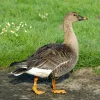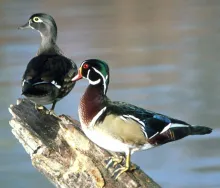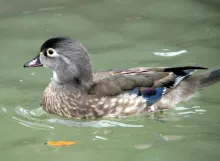
Wood duck (Aix sponsa)
Species name
- Dutch name:
- Carolina-eend
- English name:
- Wood duck
- German name:
- Brautente
- French name:
- Canard carolin
- Scientific name:
- Aix sponsa
Scientific classification
- Order:
- Anseriformes
- Family:
- Anatidae
- Onderfamilie:
- Dendrocygninae
- Genus:
- Aix
Description
- Description:
The "Wood Duck" or Carolina Duck is a perching duck found in North America. Their called Wood Duck's because they nest in tree cavities in wooded swamps and woodlands near ponds, streams and rivers!
Male:
Head iridescent green-black, extending into long crest. Thin white line from base of bill to tip of crest, second white line from just behind eye to end of crest, throat white extending dorsally to form two white lines, one behind eye, second at top of neck. Neck blackish neck blends into chest maroon spotted with white, separated by white and black vertical bars from flanks yellow/buff with fine vermiculations and narrow band of black and white striping at upper edge separating from upperparts of iridescent blue/green/black. Abdomen white, tail iridescent green/black, with brown/black/maroon coverts. Legs are yellow.Female:
Head grey with darker crown and large white ring around eye extending posteriorly into stripe, also white line around bill and small throat patch. Upperparts olive-brown, breast and flanks olive brown spotted with white, abdomen white, tail and uppertail coverts olive. Wings less iridescent and more white on tips of secondaries.Juvenile:
Similar to female but abdomen spotted with brown, less developed white ring around eye; males begin to develop white chin and throat.
Standard Measurements
- Body Length (cm):
- The male (drake) of the Wood duck measures approximately 51 centimeters. The female measures approximately 49 centimeters.
- Body Weight (grams):
- The male will weight about 680 gram. The female will weight about 540 gram.
The weight is notoriously variable and can only be used as indication!
- Note:
Wood-ducks are winter-hardy, although access to shelter may be appreciated in snow and frost. These ducks are easy to manage, popular and widely kept. They are suitable for mixed-species collections, being generally unaggressive. Feeding with grain, pellets, duckweed or other greenfood and bread is suggested.
Wood ducks are easy to breed . Raised nest boxes should be provided, although they may also lay in shelters, ground-level boxes and tunnels in banks. Nest boxes about 45-60cm high and 30cm diameter, with an entrance hole of 10cm diameter about 2/3 of the way up the box and with e.g. some wood shavings in the bottom are suggested. A ramp should be used to make the nest box accessible to flight-restricted birds. They may lay from March to June; are reliable sitters and rearers, and may produce a second clutch if the first set of eggs is removed for artificial incubation, or even after rearing the first clutch.
The ducklings may be parent reared in natural conditions, or broody reared with protection form rain and cold wind initially; they are also easily hand-reared. Hard-boiled egg and duckweed useful foods initially in addition to rearing crumbs. Pens for ducklings must be covered, as they are good climbers. They may be difficult to start feeding initially while trying to escape from the brooder by climbing out, particularly if there are only a few ducklings. Feeding with starter crumbs plus chopped hard-boiled egg and finely chopped lettuce is suggested, with some fine grit available.
These ducks are promiscuous and hybridisation is common, particularly with Red-crested pochard (Netta rufina) and Common pochard (Aythya ferina) drakes.
- Breeding:
- The female Wood duck usually lays from 8-15 white-tan eggs and incubates them for 28-33 days.
- Artificial incubating:
The ideal relative humidity for incubating most waterfowl eggs is 55% (ground nesters) and 40% (cavity nesters). The temperature is usually 37.4°C. Set ventilation as recommended by the incubator manufacturer. Eggs must be turned, either automatically or by hand, a minimum of 4 times a day. As the duckling develops there is a loss of water from the egg and the air sac gets bigger. In normal development of an egg with a 28-33 days incubation, the air sac occupies about a third of it three days earlier. Cleanliness is vital and ideally eggs should be moved to a separate hatcher at this point, where the humidity should be increased to 65% and even higher once they have pipped internally.
- Bird banding:
- Recommended closed leg band ring size for the Wood duck is 9 mm.The leg band ring can only be applied on a young perching duck at around 14 days old.
- It doesn't matter what leg that you band, but it's good to have a consistent system. Suggested: Left leg = Female, Right leg = Male
- Rearingfeed:
-



Floatable special rearing feed for all types of aquatic ornamental fowl - especially for the cultivation of trees as well as greening ducks.
This well-balanced complete feed with 20% protein content convinces above all by its good compatibility and forms the basis for visibly healthy growth from day one.
Made exclusively from wholesome and selected raw materials, Lundi Micro Regular is also ideally suited for the year-round feeding of waterfowl.
- Maintenance food:
-





Lundi Regular with a protein content of 20%, valuable Spirulina and high-quality by-products is optimally balanced in its composition maintenance food for water ornamental fowl of all kinds. Especially green teal and Whistling ducks that are not dependent on a very high protein content, are well supplied.
Lundi Regular contains all the minerals and vitamins in full form that are important for the animals. Therefore also suitable as breeding food.





Floating full food for all sea ducks, green ducks, eider ducks and geese, especially in the moulting and breeding phase ideally suited. Packed with wholesome raw materials, natural vitamins and trace elements, this performance food with a protein content of 30% forms the basis for lifelong vitality.





